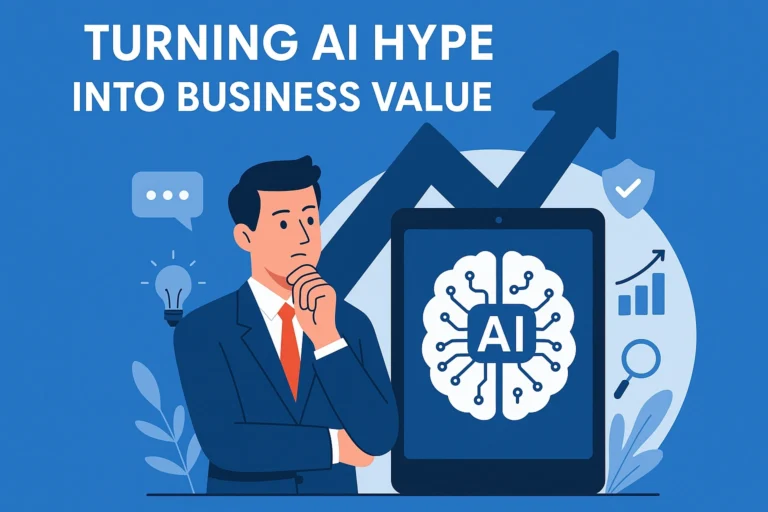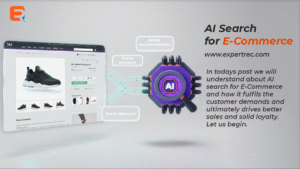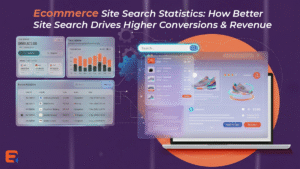Generative AI is reshaping industries — but for most e-commerce leaders, the biggest question remains: how do we turn AI hype into measurable business impact?
Many organisations experiment with AI pilots that never reach production. The technology is promising, but scaling it requires executive alignment, domain-specific data, and clear ROI goals. At ExpertRec, we’ve seen how AI can supercharge e-commerce experiences — from search and discovery to customer support and fraud prevention.
Here’s how you can apply the same strategies that worked for enterprise leaders like Elastic, tailored specifically for online retail and e-commerce.
1. AI-Powered Customer Support That Scales
The Challenge:
Customer expectations are rising while support teams are stretched thin. Shoppers want instant answers — “Where’s my order?” “Can I return this?” “Why was my payment declined?” — and they expect 24×7 availability.
The Opportunity:
Use generative AI with retrieval-augmented generation (RAG) to power a virtual support assistant trained on your product catalogue, return policies, order data, and past tickets.
This assistant can:
- Resolve repetitive queries instantly
- Help human agents find answers faster
- Understand intent in natural language (“My parcel never came” vs. “Order missing”)
- Offer consistent responses across channels (chat, email, social)
The Results:
Elastic’s own support assistant achieved:
- 6× increase in self-service issue resolution
- 23 % faster first response time
- 7 % fewer assisted support cases
- ROI achieved in just 4 months
Imagine your e-commerce helpdesk achieving the same — reduced workload, higher satisfaction, and faster resolution, all powered by your own AI-trained assistant.
How to Start:
- Begin with top FAQs (returns, shipping, cancellations)
- Index your existing knowledge (product data, ticket logs, policies)
- Pilot internally with support agents before rolling out to customers
- Track metrics like ticket deflection, CSAT, and resolution speed
2. “E-comGPT”: Your Internal Productivity Booster
The Challenge:
Your teams — from marketing to logistics — waste hours searching across dashboards, sheets, and Slack threads for information they need.
The Opportunity:
Deploy an internal AI assistant (let’s call it E-comGPT) that connects to your catalogue, CRM, order management, and analytics tools. Team members can ask questions like:
- “Which products are out of stock this week?”
- “Show me the best-selling SKUs in the US last quarter.”
- “What’s the latest NPS trend for repeat customers?”
The assistant searches, summarises, and explains insights in seconds — no dashboards, no manual filtering.
The Results:
Elastic’s internal AI assistant saved employees:
- 63+ hours per year per person
- Achieved ROI in 2 months
- Earned 98 % employee satisfaction
For e-commerce, that’s faster decisions, fewer bottlenecks, and more productive marketing, ops, and support teams.
How to Start:
- Start with one department (operations or marketing)
- Connect core data sources (catalogue, orders, marketing dashboards)
- Pilot use cases for quick wins — “top SKUs,” “inventory alerts,” etc.
- Roll out gradually across teams
3. Smarter Security & Fraud Detection with GenAI
The Challenge:
Fraudsters don’t sleep. From account takeovers to card testing and fake refunds — every e-commerce platform faces constant threats. Manual reviews can’t keep up with the scale or speed.
The Opportunity:
Use generative AI to assist fraud and security teams:
- Summarise incident logs and threat feeds
- Identify patterns and anomalies
- Generate investigation summaries automatically
- Recommend next steps for analysts
The Results:
In Elastic’s experience:
- Analysts saved 75 % of their time
- Threat report output increased by 92 %
For online stores, this means faster threat response, fewer false positives, and less revenue leakage due to fraud.
How to Start:
- Centralise fraud logs and past incident data
- Train AI models to summarise and prioritise threats
- Keep human-in-the-loop for decision-making
- Expand coverage to new attack surfaces over time
Why These Strategies Work
Generative AI isn’t just about “chatbots” — it’s about re-architecting your workflows around intelligence and context. The e-commerce companies that succeed with AI share five habits:
- Focus on real problems — customer pain, not tech novelty
- Start small, scale fast — one domain at a time
- Integrate, don’t isolate — embed AI into your existing tools
- Measure everything — define KPIs before you start
- Get leadership buy-in — executive support accelerates adoption
The ExpertRec Advantage
At ExpertRec, we help e-commerce businesses bring AI to the customer experience layer — from lightning-fast site search to intelligent product recommendations and personalised discovery.
Our platform combines:
- Vector search for semantic understanding
- Retrieval-augmented generation (RAG) for contextual responses
- Low-code deployment for easy setup
So whether you’re building your first AI-powered assistant or scaling personalisation across your store, ExpertRec can help you make AI practical, measurable, and profitable.




